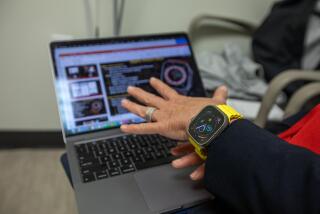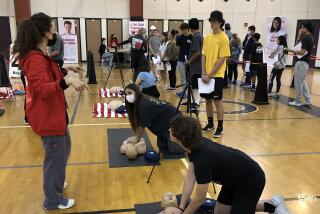Life After Heart Attack Can Be Normal
- Share via
There was a time, not that many years ago, when having a heart attack was like getting a death sentence. If you were lucky, you survived your first attack, but the second one was almost inevitable, and the idea of living out a “normal” life was farfetched.
Today, heart attacks are still the leading cause of mortality in the United States. But more people are surviving these episodes and--thanks to rehabilitation programs, improved drugs and new surgical treatments (such as coronary bypass surgery and angioplasty)--most heart attack survivors can lead normal lives (and many even enjoy normal longevity).
So how do you survive a heart attack? First, you’ve got to recognize that a heart attack is occurring. Next, you must obtain immediate medical care. And, finally, if the attack causes the heart to stop or to beat inefficiently, you must have access to cardiopulmonary resuscitation and defibrillation. It’s a series of actions known as the “chain of survival.”
Many lives are lost and hearts irreparably damaged because people do not immediately get professional care. Sometimes, it’s simply because they don’t recognize that a heart attack is occurring. Most of us have seen actors suffer “textbook” heart attacks showing only the most common symptoms: chest pain, shortness of breath and sweating.
However, a heart attack isn’t always so straightforward. In some cases, the symptoms can be very subtle. Some heart attack victims, for example, suffer little or no chest pain (they think they are just having mild indigestion). Others experience neck and jaw pain, or pain in their left shoulder or arm. Complicating things even further is the fact that heart attack victims frequently downplay or deny their symptoms. They don’t want to admit they could be having a heart attack, or they worry about what people will think if their call for help turns out to be a false alarm. Whatever the reason, failing to call 911 can make the difference between life and death, because the first few minutes are critical. This is the time when the heart can develop an abnormal rhythm that decreases blood flow to dangerous levels or, in the most severe cases, even stop pumping completely.
At this point, having someone around who can perform cardiopulmonary resuscitation can save your life. During CPR, the chest wall is compressed at regular intervals, simulating the normal pumping action of the heart and helping circulate blood. Cardiopulmonary resuscitation is by no means as effective as a normally functioning heart, but it buys some time for the heart attack victim until professional help arrives.
You should call 911 as soon as you suspect someone is having a heart attack. Don’t make the mistake of calling a doctor, neighbor or relative first, as many people do. This delays the arrival of people who can help during the early critical moments. And don’t drive the person having a heart attack to the hospital yourself; it’s risky making that trip without medical personnel and immediate access to an automated electrical defibrillator.
A defibrillator, which paramedics carry with them, delivers an electrical charge, or shock, to the chest wall capable of converting an abnormal rhythm back into a normal one and reestablishing normal circulation. When defibrillators are used within the first five minutes of a cardiac arrest, the chance of survival is about 50%. The likelihood of survival drops by as much as 10% with each minute after that, and after 10 minutes the chances of survival fall to almost zero.
Remembering and following the chain of survival can reduce the risk of death when a heart attack occurs. But the best approach to heart attacks is prevention. You can lower your risk of having one by not smoking, exercising regularly, eating a low-fat diet, controlling your blood cholesterol levels, maintaining a healthy weight and keeping your blood pressure in check.
While you’re at it, consider learning how to do CPR yourself, just in case someone around you has a heart attack. The sooner CPR is initiated, the better.
Individuals who receive CPR quickly (before the paramedics get there) are much more likely to survive than those who must wait for them to arrive. Courses in CPR are offered by the American Heart Assn. For specific information about these courses, visit the Web site at https://www.cpr-ecc.org.


